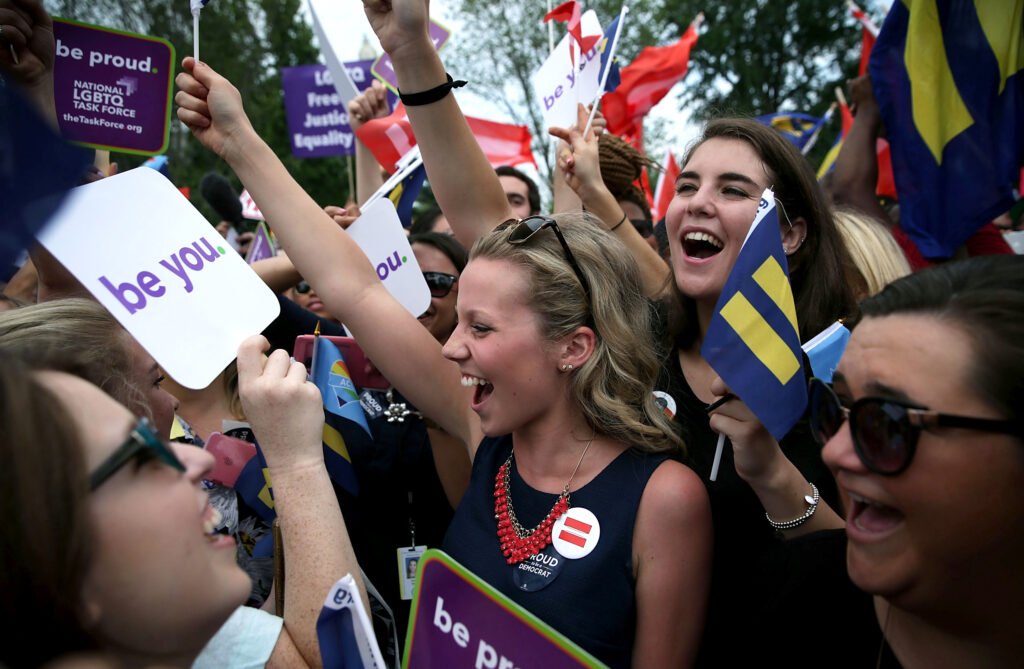
ABSTRACT
The question of whether same-sex couples should be allowed the same marital rights as heterosexual couples is a contentious issue that has been debated for many years. Proponents of same-sex marriage argue that denying same-sex couples the right to marry is discriminatory and a violation of their human rights. They argue that same-sex couples should have the same legal and societal recognition as opposite-sex couples, including the right to marry, adopt children, and receive the same benefits and protections afforded to married couples.
Opponents of same-sex marriage argue that marriage should only be between a man and a woman, as it has been traditionally defined. They often argue that same-sex marriage undermines the institution of marriage and is against the natural order of things. Some opponents also argue that allowing same-sex couples to marry would have negative consequences for children raised in same-sex households.
Despite these arguments, the trend towards legalizing same-sex marriage has been growing in many countries around the world. As of 2021, over 30 countries have legalized same-sex marriage, and several others recognize some form of legal recognition for same-sex couples.
In conclusion, the debate over same-sex marriage is complex and multifaceted, with strong arguments on both sides. However, the trend towards legalizing same-sex marriage suggests that society is moving towards greater acceptance and recognition of same-sex couples, and towards a more inclusive and equal society for all.
LEGAL ASPECTS
From a legal standpoint, the question of whether same-sex couples should be allowed the same marital rights as heterosexual couples is one that has been debated in many countries around the world. The legal aspects of this issue vary depending on the country in question, but there are some common themes that emerge.
In countries where same-sex marriage is legal, same-sex couples enjoy the same legal rights and protections as opposite-sex couples. This includes the right to marry, divorce, adopt children, and receive benefits and protections afforded to married couples, such as inheritance rights and healthcare benefits.
In countries where same-sex marriage is not legal, same-sex couples may still have some legal recognition, such as civil partnerships or domestic partnerships. However, these legal arrangements do not offer the same level of legal rights and protections as marriage, and may not be recognized in other countries.
The legal battle for same-sex marriage has been a long and ongoing one, with many countries having to pass legislation or amend their constitutions in order to legalize same-sex marriage. This often involves overcoming legal challenges and opposition from conservative groups who argue that same-sex marriage undermines the traditional institution of marriage.
In conclusion, the legal aspects of whether same-sex couples should be allowed the same marital rights as heterosexual couples are complex and vary depending on the country in question. However, the trend towards legalizing same-sex marriage suggests that society is moving towards greater acceptance and recognition of same-sex couples, and towards a more inclusive and equal society for all.
CASE LAWS
There have been several landmark case laws related to same-sex marriage and the legal rights of same-sex couples. Here are some examples:
Obergefell v. Hodges (2015) – This US Supreme Court case legalized same-sex marriage throughout the United States. The Court held that the right to marry is a fundamental right guaranteed by the Fourteenth Amendment, and that same-sex couples have the same right to marry as opposite-sex couples.
Goodridge v. Department of Public Health (2003) – This Massachusetts Supreme Judicial Court case was the first in the United States to legalize same-sex marriage. The Court held that the state’s ban on same-sex marriage violated the Massachusetts Constitution.
Schalk and Kopf v. Austria (2018) – This European Court of Human Rights case held that Austria’s ban on same-sex marriage violated the European Convention on Human Rights. The Court held that same-sex couples have the same right to marry as opposite-sex couples.
National Coalition for Gay and Lesbian Equality v. Minister of Justice (1998) – This South African Constitutional Court case held that the country’s ban on same-sex marriage was unconstitutional. The Court held that the ban violated the country’s Bill of Rights, which prohibits discrimination on the grounds of sexual orientation.
Navtej Singh Johar v. Union of India (2018) – This Indian Supreme Court case decriminalized homosexuality in the country and recognized the legal rights of same-sex couples. The Court held that the country’s ban on homosexuality violated the Indian Constitution’s guarantees of equality and liberty.
These landmark case laws have played a significant role in advancing the legal rights of same-sex couples and promoting greater acceptance and recognition of LGBTQ+ individuals around the world.
CONCLUSION
In conclusion, the question of whether same-sex couples should be allowed the same marital rights as heterosexual couples is one that has been debated for many years. Proponents argue that same-sex couples deserve equal legal recognition and societal acceptance, while opponents often argue that marriage should only be between a man and a woman.
However, the trend towards legalizing same-sex marriage in many countries around the world suggests that society is moving towards greater acceptance and recognition of same-sex couples. Legalizing same-sex marriage not only provides same-sex couples with legal protections and benefits, but it also sends a message of inclusivity and equality.
While there are still legal and societal barriers to overcome, the progress towards recognizing and legalizing same-sex marriage is a step towards a more just and equal society for all. It is important to continue the dialogue and push for greater acceptance and legal recognition of all individuals, regardless of their sexual orientation or gender identity.
